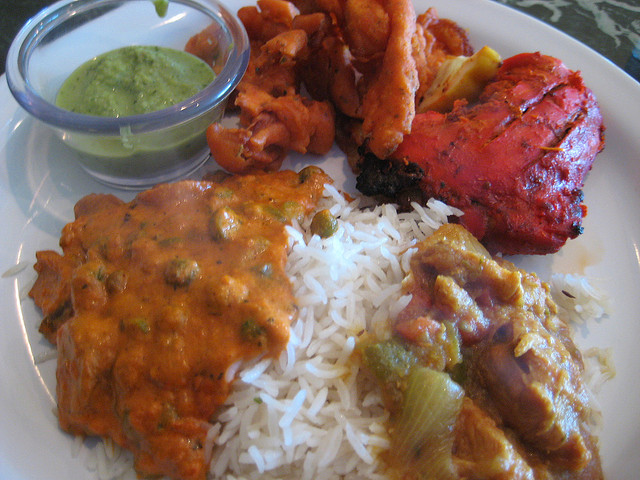Food Delivery Makeover: 10 Easy Tips on How to Order Healthy Indian Food
Indian food is one of the most popular cuisines out there when it comes to food delivery for the office… but it’s also one of the most mystifying to health-conscious diners. After all, there are certainly plenty of vegetarian dishes on Indian menus, but many seem so creamy and rich!
Indeed, thanks to the frequent use of ghee (clarified butter), coconut oil or milk, and the good old frying pan, some Indian dishes may seem healthy — hey, it’s spinach! — but are actually considerably higher in fat and calories than you might expect.

Image source: Flickr user Jason Walsh
So, feel like you need a little help at ordering healthy Indian food delivery? We’ve got some expert tips in store!
Five foods to make your Indian lunch a healthy one:
1) Ordering dal with your meal is a nutritional no-brainer: it’s like having a little takeout dish of pure protein and fiber! Usually made from lentils and a little soupy in texture (at least in American restaurants), a healthy dose of dal will help keep you full and satisfied – without weighing you down – all afternoon.
2) Many Indian dishes are a vibrant yellow color because of turmeric, an ancient spice that might be secretly packing all kinds of anti-inflammatory, antioxidant-boosted nutritional powers. Take advantage of turmeric’s benefits — and its delicious flavor — by ordering aloo gobi. In this colorful dish, small hunks of potatoes and cauliflower are cooked with many spices in a moderate amount of oil, making it a healthy food delivery choice. Pair with a side of dal if you’re worried about not being satisfied by cauliflower and potatoes alone!
3) When it comes to meat, think tandoori! A tandoor is a traditional clay oven that uses super-high heat to cook chicken, fish, and other meats. Since it’s a nice dry heat, versus frying or sautéing, tandoori meats are some of the healthiest options on the menu at many Indian restaurants — many are served kebab-style, or choose chicken tikka (not chicken tikka masala, which is a very different and creamier dish) for a classic Indian lunch.
4) Raita is yogurt-based (kind of like Greek tzatziki), meaning you’ll get a little extra protein when you dunk your tandoori kebabs in this refreshing yet creamy sauce.
5) Can’t imagine an Indian meal without one of its delicious breads? Instead of the ubiquitous, often-buttered naan, opt for a reasonable portion of chapati — made with whole wheat flour, chapati will provide a bit more fiber and protein, giving you a bigger bang for your caloric buck.
And five kinds of dishes to avoid:
1) This may be common sense, but keep away from fried items, like pakora or samosas. While delicious, they’re also quite high in saturated fat.
2) Even vegetarian dishes studded with paneer, a kind of cheese, can actually be packed with fat. For instance, some restaurants pack their palak paneer with more cheese than spinach, and then cut the sauce with cream as well, making this popular vegetarian dish a total calorie bomb.
3) Ghee, a traditional clarified butter, is what gives many sauces their incredible depth, texture, and loads of saturated fat! (Note that this may be up for debate: some groups believe that lactose-free ghee is actually a very healthy source of fat, and most Western nutritionists just have yet to realize it.)
4) If you see malai on the menu, it means cream… and along with ghee, malai is the reason Indian gravies are so rich. Again, they also add considerable fat and calories to otherwise-healthy dishes, so you’ll be better off with tomato-based sauces or tandoori-cooked meats instead.
5) Keep in mind that basmati rice served alongside your chicken tikka could tack 200 calories onto your meal… without providing much nutritional heft to make it worth your while. Rather than eating the whole container, just have a small helping for flavor… and more protein-and-fiber-packed dal instead.
And just keep in mind, every restaurant is different, and cooking methods will vary based on the traditions and preferences of the chef in the kitchen. These guidelines will certainly help you get closer to knowing how to order healthy, wholesome Indian food delivery — and with easy online ordering and prompt delivery service, Waiter.com will take care of the rest!